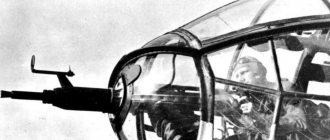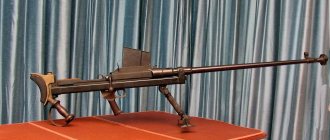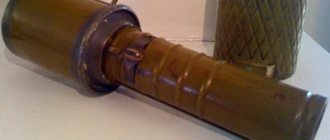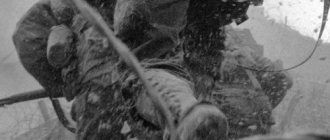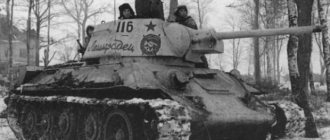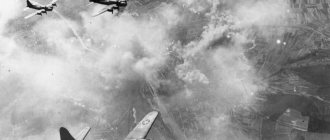On June 22, 1941, Operation Barbarossa (attack on the USSR) began, and the hitherto victorious roller of the German Wehrmacht collided with the new Soviet T-34 and KV tanks, almost falling apart. If the medium T-34s were still difficult to stop with the available means, then only 88-mm anti-aircraft guns could cope with the heavy KV.
The fact is that the main German 37-mm anti-tank gun could hit T-34 tanks at a distance of only 300 meters, and KV tanks only from 100 meters. Thus, one of the reports said that the crew of the 37-mm cannon achieved 23 hits on the same T-34 tank, but only when the shell hit the base of the turret was it disabled. After the first battles, German soldiers dubbed their 37 mm anti-tank guns “door knockers” or “army firecrackers.”
Experimental design work on the creation of heavy self-propelled guns has been carried out in Germany since the early 1940s and even led to local successes. In the summer of 1942, two 128-mm self-propelled guns based on the VK 3001(H) were sent to the Eastern Front near Stalingrad. One of these vehicles was lost in battle, the other, along with the remaining equipment of the 521st Tank Destroyer Division, was abandoned by the Wehrmacht after the defeat at Stalingrad in early 1943.
Soviet T-34 tanks in battle. View from the driver's mechanic's hatch.
Moreover, even the death of Paulus’s 6th Army did not in any way affect the launch of similar self-propelled guns into series. The prevailing idea in society and ruling circles was that the war would end in victory for Germany. Only after the defeat on the Kursk Bulge, in North Africa and the landing of the Allies in Italy, many Germans, blinded by propaganda, realized the reality - the combined forces of the countries of the Anti-Hitler coalition were many times greater than the forces of Germany and Japan, only a “miracle” could save the dying German state.
The emergence of self-propelled anti-tank artillery was a logical consequence of the evolution of the development of tactics of confrontation between artillery guns and tanks. Anti-tank self-propelled guns were able to fight enemy tanks more effectively; they were able to support the attack of their own infantry and armored vehicles, destroying enemy anti-tank weapons.
In World War II, German self-propelled artillery used a large number of different chassis, obsolete and in production. Experienced and captured tanks and armored personnel carriers.
Self-propelled artillery units in Germany were divided into:
- self-propelled gun (Selbsgtfahrlafette)
- assault gun (Sturmgeschutz)
- tank destroyer (Panzerjager)
- tank fighter (Jagdpanzer)
- assault tank (Sturmpanzer)
- gun transporter (Waffentrager)
German self-propelled artillery was divided into:
- anti-tank
- assault
- field
The main task of the self-propelled gun was to escort infantry. For this, assault guns were needed, which, moving in infantry combat formations, suppressed machine guns and other targets that interfered with the infantry's advance. The assault guns were armed with artillery pieces ranging in caliber from 75 mm to 380 mm. To combat enemy tanks, tank destroyers, fighter tanks, and self-propelled guns armed with anti-tank guns were used. Tank destroyers and tank destroyers were armed with 47, 75, 88 and 128 mm artillery systems.
"Sturer Emil"
Self-propelled gun 12.8 cm PaK 40 L/61 Henschel Selbstfahrlafette auf VK-3001(N)
The Germans urgently needed anti-tank weapons capable of fighting on equal terms with the new Soviet armored vehicles. Naturally, we remembered the 105 mm and 128 mm self-propelled gun projects. In mid-1941, Rheinmetall Borsig issued an order to develop a self-propelled carriage (Selbsfarhlafette) for 105 mm and 128 mm anti-tank guns. The Pz.Kpfw.IV Ausf.D chassis was quickly adapted for the 105 mm gun, and the 105 mm Dicker Max self-propelled gun was born.
For the 128-mm Pak 40 L/61 gun with a barrel length of 61 calibers, developed on the basis of the 128-mm Flak 40 anti-aircraft gun, equipped with a swinging armored mask and a muzzle brake, we had to look for a different chassis - the Pz.Kpfw.IV simply could not withstand it. The designers used the chassis of the experimental tank VK-3001(H). However, even though this chassis “lifted” a seven-ton gun, there was no room left to place ammunition and crew. The chassis had to be lengthened almost twice - four road wheels were added to the chassis. The gun was placed in an open conning tower with frontal armor 45 mm thick, providing horizontal aiming angles of 7° in each direction, and vertical aiming angles from -15° to +10°. The new self-propelled gun was equipped with a 6-cylinder Maybach “HL 116” engine with a power of 265 hp, which made it possible, with a mass of about 35 tons, to reach a maximum speed on the highway of 18-19 km/h.
By March 1942, it produced two prototypes of the self-propelled gun, designated 12.8 cm PaK 40 L/61 Henschel Selbstfahrlafette auf VK-3001(H). The prototypes had their own names - “Max” and “Moritz”. In mid-1942, they underwent combat tests on the Eastern Front, operating as part of the 521st Pz.Jag.Abt (a battalion of self-propelled tank destroyers), armed with light self-propelled guns Panzerjaeger I. At the front, due to frequent breakdowns, the self-propelled gun was given the nickname “Sturer Emil” "("Stubborn Emil").
Tactical and technical characteristics of the German self-propelled gun "Sturer Emil"
- weight - 35 tons (full ammunition).
- armament - 128 mm Pak 40 L/61 rifled gun.
- ammunition - 15 shells.
- additional weapons - 1 frontal machine gun 7.92 mm MG-34.
- armor - steel, rolled.
- engine - V6 cylinder, petrol Maybach HL 116 (300 hp).
- speed - 18 km/h (maximum).
- crew - 5 people.
- released - 2 combat models, both took part in battles.
- the approximate cost is 190,000 Reichsmarks for one self-propelled gun.
German self-propelled gun "Sturer Emil" with tanks marked on the barrel.
One self-propelled gun was destroyed in battle, and the second was captured by the Red Army near Stalingrad in January 1943. The barrel of her gun bore marks on 22 units of damaged Soviet equipment. This vehicle was demonstrated in 1943 and 1944 at an exhibition of captured weapons, and is now on display in the museum of the Kubinka BTT Research Institute.
In mid-1942, self-propelled guns underwent combat tests on the Eastern Front, operating as part of the 521st Pz.Jag.Abt
The evaluation of the self-propelled gun based on test results was ambiguous. On the one hand, its powerful 128 mm cannon easily penetrated the armor of any Soviet tank. On the other hand, the vehicle was slow, the chassis was overloaded, repairing the engine was a huge problem (it was located directly under the base of the gun), the gun had very limited aiming angles, and the ammunition load was only 18 rounds (according to other sources - 15 rounds). It is quite natural that the car did not go into production.
From the report of the commander of a heavy anti-tank battalion: the Sturer Emil self-propelled gun confidently destroys Soviet tanks from distances of 1 and 1.2 km, but only if its position is hidden. The self-propelled gun lacks maneuverability (due to the low-power engine), and the ammunition load is too limited. The frontal armor is quite tolerable, but the vehicle is very vulnerable from the flank and stern.
The gun's low rate of fire and small horizontal aiming angle greatly hinder its actions on the battlefield.
As a result, the report of the German commander and the identified shortcomings of the self-propelled gun stopped its launch into production. Priority was given to other models, but the Sturer Emil self-propelled gun will remain in history as one of the first models with such a powerful weapon.
It was then that talk began about a “miracle weapon” that could change the course of the entire war. Such rumors officially became German propaganda, which promised the people of Germany a quick change in the situation on the fronts. At the same time, there were no developments sufficiently effective in global terms (nuclear weapons and their analogues) at the final stage of readiness in Germany. Therefore, the Reich leadership was forced to seize on any somewhat significant military-technical projects that, with their originality and unusualness, along with defensive capabilities, could also perform psychological functions, instilling in the people thoughts about the strength and power of the state, which is capable of creating such complex equipment. It was in such a situation that the heavy tank destroyer, the Jagdtiger self-propelled gun, was created and put into production. Jagdtiger became the heaviest example of serial armored vehicles produced during the Second World War.
Jagdtiger
Having analyzed the experience of using various anti-tank self-propelled guns and assault guns in combat conditions, the Armament Directorate in the summer of 1942 turned to the idea of creating fully armored tank destroyers armed with large-caliber guns with a high initial projectile velocity.
And in the fall of the same year, Hitler issued an order to begin the development of an armored self-propelled anti-tank system armed with a long-barreled 128 mm gun. During its preliminary design, which began in 1943, the rearmament of the Ferdinand self-propelled gun with a 128-mm RaK 44 L/55 cannon was considered as one of the options, but the Armament Directorate pushed for the use of the chassis of the designed Tiger II tank.
A wooden model of the new machine was demonstrated to Hitler on October 20, 1943 in Aris. The machine made the most favorable impression on the Fuhrer, and it was ordered to prepare its mass production next year. On April 7, 1944, Hitler gave the new self-propelled gun the name “Panzerjager Tiger” (SdKfz 186), and on April 20, 1944, it began mass production. The initial order was for 100 vehicles, but production did not go well until the fall of 1944, and on October 16, 1944, the Allies carried out a massive air raid on them, dropping about 143 tons of bombs on them. After this, no more than 20 Jagdtigers were manufactured here until the end of the war. In total, during mass production, the Germans managed to produce about 70 vehicles, which were rightfully considered the most powerful anti-tank self-propelled guns of the Second World War.
The first Jagdtigers, which left the gates of the manufacturing plant in March 1944, entered service with the third company of the 130th training anti-tank battalion. After this, all Jagdtigers arriving at the front entered service with the 512th and 653rd heavy anti-tank battalions.
“Jagdtiger” (“Panzerjager Tiger” SdKfz 186). "Jagdpanzer VI", and later - "Panzerager Tiger" or briefly: "Jagdtiger".
In March 1945, the first company of the 512th battalion took part in the battles at the Remagen Bridge. At this time, it had only half of its staff - 6 Jagdtigers, but nevertheless successfully destroyed Allied tanks, suffering virtually no losses. The second company in April 1945 took part in the battles in the Ruhr region, here its self-propelled guns knocked out 36...40 American tanks in five days of fighting.
Nine Jagdtigers of the 512th battalion were sent to Austria, where they operated as part of the 6th SS Panzer Army. On the evening of May 9, 1945, the remnants of the unit, consisting of three self-propelled guns, having collected all available fuel, broke through to the demarcation line, destroying two IS-2 tanks and two T-34s along the way, after which they surrendered to American troops.
The 653rd Heavy Anti-Tank Battalion entered the battle in early December 1944 as part of the 5th Tank Army, inflicting heavy losses on the advancing Anglo-American tank units. So on December 7, one “Jagdtiger”, straddling a crossroads, destroyed 19 “Shermans” in three hours, without receiving a single hole during the battle (according to the Germans, the Americans even shot very poorly and achieved only four tangent hits during the entire period battle).
"Jagdtiger". Drawing of a tank destroyer.
Assembling the running Jagdtiger self-propelled gun (as well as the Tiger II tank itself) was the most labor-intensive operation, which significantly delayed the production process. That is why the design bureau of Ferdinand Porsche, as a private initiative, made a proposal to use on this self-propelled gun a suspension similar to that installed on the Ferdinand tank destroyer.
Its peculiarity was that the torsion bars were not located inside the body, but outside inside special bogies. Each of these longitudinally located torsion bars served 2 road wheels. The weight gain when using such a suspension was 2,680 kg. In addition, installation and tightening of the torsion bars of the standard Henschel suspension was only possible in the assembled body, in strict sequence, using a special winch. Replacement of suspension balancers and torsion bars could only be carried out in the factory. The assembly of the Porsche design suspension could be carried out separately from the body, and installation was carried out without the use of special equipment. Repair and replacement of suspension units could be carried out in front-line conditions and did not present any particular difficulties.
A total of 7 vehicles with a Porsche suspension design were manufactured (5 production samples and 2 prototypes); the first Jagdtiger with a Porsche suspension entered testing even earlier than the self-propelled guns with the Henschel suspension. However, despite all the advantages of the Porsche suspension, on the recommendation of the Armament Directorate, another vehicle went into production. The main reason was the more than strained relationship between the famous designer and ministry officials, as well as the breakdown of one of the carts during testing, which, by the way, was the fault of the manufacturer. We also cannot discount the fact that the Armament Directorate wanted to achieve maximum unification between the self-propelled guns and the Royal Tiger tank.
"Jagdtiger" with suspension designed by Porsche.
In total, from July to April 1945, from 70 to 79 similar self-propelled guns were assembled in Germany, so there was no talk of any mass use of them. Most often, the Jagdtiger self-propelled guns entered battle in platoons, or individually, as part of hastily formed combat groups. The chassis of the vehicle was too overloaded, which led to low mobility and frequent breakdowns. For this reason, the design of the self-propelled guns provided for the installation of two stationary demolition charges. One was under the gun breech, the second under the engine. Most of the self-propelled guns were destroyed by their own crews, when it was impossible to tow the vehicle to the rear. The use of the Jagdtigers was sporadic, but any appearance of them in battle was a big headache for the allies. The gun mounted on the self-propelled gun made it possible to easily hit any Allied tank from an extreme distance of 2.5 km.
Performance characteristics of Jagdtiger
- weight: 75.2 t.
- weapons: 128 mm StuK44 L/55 cannon, 7.92 mm MG-34 machine gun
- ammunition: 40 rounds, 1500 rounds
- armor: from 40 to 250 mm.
- Engine: 12-cylinder liquid-cooled Maybach HL HL230Р30 petrol engine, 700 hp.
- maximum speed: on the highway – 36 km/h, over rough terrain – 17 km/h
- overall dimensions: length 10.654 m, width 3.625 m, height 2.945 m.
- crew: 6 people
- Cruising range: on the highway – 170 km, over rough terrain – 120 km.
It was planned to arm the largest tank of World War II, the Maus (Type 205), with a 128-mm cannon. Despite Hitler's instructions in June 1943 to replace it with a more powerful 150 mm gun, the only fully completed tank prototype was equipped with a turret with a 128 mm KwK.44 L/55 gun. It was installed in a common cast mantlet with a 75 mm cannon and an MG 34 machine gun. At the bottom of the turret there was a compressor designed to purify the barrel bore after a shot. The ammunition load of the 128-mm cannon was 68 rounds of separate loading. After the installation of weapons, on October 3, 1944, the Maus tank (prototype 205/1) was tested at the Kumersdorf training ground, but there is no information about whether the weapons were tested.
With the outbreak of the war with the Soviet Union, towed anti-aircraft guns turned out to be the only German guns capable of confidently hitting Soviet KV and T-34 tanks from a distance of 1.5 km or more. However, some of their design features, primarily their high profile, made them unsuitable for camouflage on the ground, and therefore, for use in anti-tank defense. Accordingly, efforts were made to create specialized anti-tank guns based on the ballistics of existing anti-aircraft guns. This is how the 88-mm PaK 43 anti-tank gun appeared, developed on the basis of the 88-mm anti-aircraft gun (“Gerät 42”) and put into service in 1943. It easily hit any Allied tank head-on at all reasonable combat distances.
128-mm anti-tank gun in transport position on a three-axle carriage
Exploitation
The D-48 guns were not in production for long - only until 1957. The gun was produced in China a little longer.
Soviet D-48s were supplied in small quantities to the countries of the Warsaw Pact Organization, Chinese analogues were supplied to Pakistan and African countries.
The anti-tank value of the gun quickly faded away, but the system was not removed from service in the Soviet Union. According to some information, 85 mm guns were used during the first Chechen campaign. Currently, the gun is not in service with the Russian Army.
In 2016, a certain number of D-48s were in Mongolia and Mozambique. In addition, in 2015, Ukraine was going to reactivate the 85 mm guns available in warehouses for their use in the civil war.
Pak 44 anti-tank gun
In the same 1943, German specialists, in yet another attempt to create a Wunderwaffe - a “miracle weapon”, began working on an even more powerful anti-tank gun based on the 12.8 cm Flak 40. Work was also carried out by Rheinmetall-Borsig, which submitted its own for testing prototypes. They had a shorter barrel compared to the anti-aircraft gun (55 calibers versus 61) and a “salt shaker” muzzle brake to reduce recoil.
128-mm Pak 44 anti-tank gun in transport (top) and combat (bottom) position
Since it was not possible to install such a heavy barrel on the existing carriages, to transport the Rheinmetall prototype, the company, which specialized in the production of trailers, designed a special three-axle carriage with two pairs of wheels in front and one in the rear. When put into firing position, the front wheels were raised, the rear wheels were removed, and the gun was hung on cross-shaped supports. But at the same time, the high profile of the gun was maintained, which made the gun extremely noticeable on the ground. An armor shield was provided to protect the crew.
The prototype gun was mounted on a specially designed cross-shaped carriage, similar to the carriage of the 88-mm Flak 36/37 anti-aircraft gun, which provided all-round fire and a vertical aiming angle from -8° to +45°. In the stowed position, the Pak 44 was towed on 4 wheels with rubber tires, thanks to which highway towing could be carried out at speeds of up to 35 km/h.
Based on the results of the tests, it was decided to adopt the “Krupp” product. Production of the 128-mm anti-tank gun, designated Pak 44 L/55, began in December 1943 and 18 of these guns were produced by March of the following year.
Due to its very solid caliber, the Pak 44 turned out to be the only German anti-tank gun with separate case loading. However, thanks to the semi-automatic bolt, the gun's rate of fire was 5 rounds/min. Firing was carried out with armor-piercing (Pzgr.43) and high-explosive fragmentation (Sprgr. L/4.5) shells. The gun could successfully fight any Soviet, American or British tank at distances beyond their reach. An armor-piercing projectile at a range of 500 m penetrated armor 217 mm thick, at ranges of 1000 and 1500 m - 200 and 187 mm, respectively. The large mass of the projectile when it hit the tank in 90% of cases guaranteed its failure even without penetrating the armor. However, this “Thor’s hammer” also had disadvantages - with a gun weight of 10 tons, it could only be towed by 12- or 18-ton half-track tractors, of which there were few. In addition, due to its large size, the Pak 44 was difficult to camouflage.
Design
D-48 has a classic layout with a carriage with 2 sliding beds. The monoblock barrel is equipped with a 2-chamber active muzzle brake, which absorbs about 70% of the recoil energy. The shutter is a vertical wedge with a semi-automatic mechanism. Above the barrel there is a hydraulic recoil brake and a pneumohydraulic knurler. The lifting and turning mechanisms of the implement are screw-type and driven manually.
The D-48 wheels are unified with the vehicle components from the ZiS-5 truck. “Artillery” wheels differ from ordinary wheels by bullet-resistant tires filled with spongy rubber. The suspension of the chassis is torsion bar and is automatically switched off when the frames are moved apart. The beds are hollow box-shaped pipes with openers located at their ends.
If necessary, the relatively small mass of the gun allows it to be moved manually; to do this, a roller must be placed under the long barrel.
For direct fire, the K-1 open collimator sight is used; for more accurate aiming, an optical sight model OP-2 or OP-4 was used, giving a magnification of 5.5 times. For firing from closed positions, the open sight was supplemented with a Hertz PG-1 panorama. Some of the guns were equipped with night sights.

